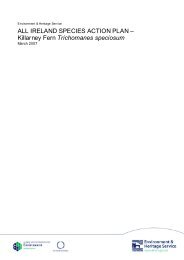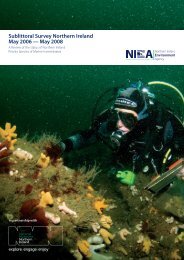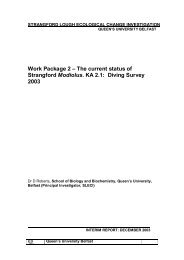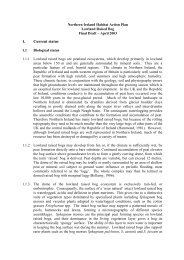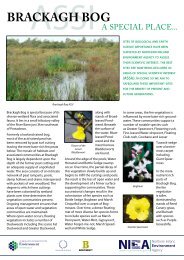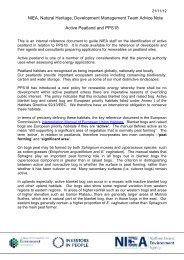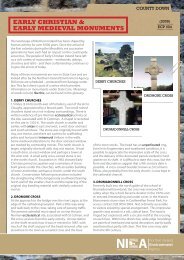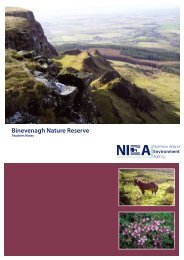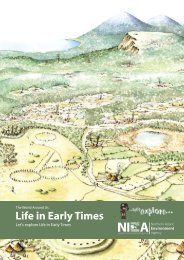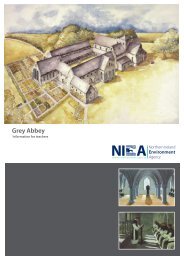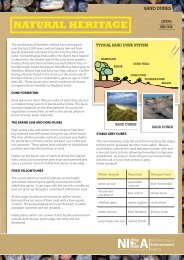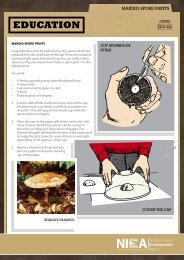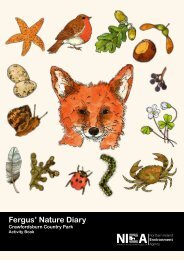Nessa Newt's Wetland and Bog Biodiversity Book
Nessa Newt's Wetland and Bog Biodiversity Book
Nessa Newt's Wetland and Bog Biodiversity Book
Create successful ePaper yourself
Turn your PDF publications into a flip-book with our unique Google optimized e-Paper software.
<strong>Nessa</strong> Newt’s <strong>Wetl<strong>and</strong></strong> <strong>and</strong> <strong>Bog</strong><br />
<strong>Biodiversity</strong> <strong>Book</strong><br />
NIEA <strong>Biodiversity</strong> Activity <strong>Book</strong><br />
For Upper KS1 Pupils<br />
www.ni-environment.gov.uk Agency<br />
Northern Irel<strong>and</strong><br />
Environment
Teacher notes.<br />
Education <strong>and</strong> the Northern Irel<strong>and</strong> Environment Agency<br />
Life on our planet = <strong>Biodiversity</strong>!<br />
<strong>Biodiversity</strong> simply means the total variety of life on our planet. The state of the world’s<br />
<strong>Biodiversity</strong> was the central focus at the United Nations Conference on Environment <strong>and</strong><br />
Development that was held in Rio de Janeiro in June 1992. 156 countries signed an agreement<br />
at this conference to conserve the earth’s <strong>Biodiversity</strong>. Northern Irel<strong>and</strong> has a great level of<br />
<strong>Biodiversity</strong>, with many different habitats <strong>and</strong> 22000 species that we can name so far!<br />
N.I.E.A (Northern Irel<strong>and</strong> Environment Agency) believe that it is vitally important to educate<br />
people about their planet’s <strong>Biodiversity</strong> <strong>and</strong> how it is important in terms of the quality of<br />
their daily lives. Obviously the word ‘<strong>Biodiversity</strong>’ can appear large <strong>and</strong> is too difficult a<br />
term <strong>and</strong> concept for KS1 pupils. Despite this we feel that through this series of <strong>Biodiversity</strong><br />
Activity booklets even very young children can begin to focus on certain creatures, plants<br />
<strong>and</strong> habitats that are important to their local <strong>Biodiversity</strong> while at the same time covering<br />
important curriculum components. This will hopefully mean that when they encounter the<br />
word ‘<strong>Biodiversity</strong>’ <strong>and</strong> the greater details of the concept at a later age it will not be such a<br />
problem for them, having already encountered the term <strong>and</strong> studied many basic elements of<br />
the concept when they were younger.<br />
<strong>Book</strong>s available in this series:<br />
Harry Hare’s Field <strong>and</strong> Farm <strong>Biodiversity</strong> Activity booklet.<br />
<strong>Nessa</strong> Newt’s <strong>Wetl<strong>and</strong></strong> <strong>Biodiversity</strong> Activity booklet.<br />
Owen Otter’s River <strong>Biodiversity</strong> Activity booklet.<br />
Sarah Seal’s Coastal <strong>Biodiversity</strong> Activity booklet.<br />
For more information on these topics or to locate more copies of our resources contact:<br />
The Education Manager<br />
Corporate Communications<br />
Northern Irel<strong>and</strong> Environment Agency<br />
Klondyke Building<br />
Cromac Avenue<br />
Gasworks Business Park<br />
Lower Ormeau Road<br />
Belfast BT7 2JA<br />
Tel: 0845 3020008<br />
Copyright: Crown copyright
Here is your very own chart for you to record how well you have done.<br />
Put a tick or a stamp in the space when you finish a page.<br />
1 I know what a smooth newt is<br />
2 I know where the peat bogs are<br />
3 I know if it is an animal or a plant<br />
4 I know the seasons on the bog<br />
5 I know what we use peat for<br />
6 I know about peat moss<br />
7 I know about Bianca the butterfly<br />
8 I know how things move<br />
9 I know about birds that live on the bog<br />
10 I know about animals on the bog<br />
11 I know about the plants on the bog<br />
12 I know about <strong>Nessa</strong>’s<br />
pond dipping<br />
13 I know what the bog plants look like<br />
14 I know about pond life<br />
15 I know about differences <strong>and</strong> similarities<br />
16 I know about animals <strong>and</strong> their young<br />
17 I know what sort of creature it is<br />
18 I know why we should look after our peat bogs<br />
19 I know about the peatl<strong>and</strong> wordsearch<br />
20 I know about camouflage<br />
21 I know how a butterfly grows<br />
22 I know how to do the peat bog quiz<br />
23 I know how to make a frog mask<br />
Well done you really are learning a lot about <strong>Wetl<strong>and</strong></strong>s <strong>and</strong> <strong>Bog</strong>s.
Hello I am <strong>Nessa</strong> the Newt. I am a smooth Newt <strong>and</strong> I live on<br />
a peat bog. I like to live in damp places. I have smooth moist<br />
skin <strong>and</strong> four toes on my front feet. I am green <strong>and</strong> brown. I<br />
like to eat pond snails, tadpoles, worms <strong>and</strong> insects.<br />
Peat bogs are very wet places. You would need to wear your wellies there. Peat<br />
bogs are covered in peat which is a type of soil made from plants <strong>and</strong> trees<br />
which were alive a long time ago. When they died, they fell onto the ground<br />
<strong>and</strong> rotted. After many years they turned into peat.<br />
I hope you like my Activity <strong>Book</strong> all about peat bogs. There are<br />
lots of things for you to do.<br />
1
Where are the Peat <strong>Bog</strong>s in Northern Irel<strong>and</strong>?<br />
There are many peat bogs in Northern Irel<strong>and</strong> because our weather is cold <strong>and</strong><br />
wet, which helps them to grow. In Northern Irel<strong>and</strong> there are more peat bogs<br />
than forests. But in the last 100 years some of the peat bogs have been<br />
destroyed.<br />
Here is a map of Northern Irel<strong>and</strong>. All the peat bogs are marked on it.<br />
Enniskillen<br />
L/Derry<br />
l Colour the peat bogs brown.<br />
l Colour the rest of the l<strong>and</strong> green.<br />
l Colour the sea <strong>and</strong> Lough Neagh blue.<br />
Choose the right word for this sentence:<br />
Lough Neagh<br />
Newry<br />
Belfast<br />
Most of the peat bogs in Northern Irel<strong>and</strong> are in the north/south/east/west.<br />
2<br />
N<br />
W E<br />
S
Is it an Animal or a Plant?<br />
Here are some animals <strong>and</strong> plants that like to live on peat bogs. Animals usually<br />
move around to find food. Plants usually grow in the ground. They do not move<br />
around.<br />
Draw a circle around each animal<br />
l Name one of these animals that eats plants ___________________<br />
l Name one of these animals that eats other animals ___________________<br />
3
Seasons on the Peat <strong>Bog</strong><br />
Peat bogs look different in each season of the year. Fill in the blank spaces to<br />
find the right answer.<br />
Spring<br />
These white flowers are the first sign of spring<br />
Frogs lay these eggs in ponds in spring<br />
Blue flowers which are shaped like a bell<br />
Birds build these to lay their eggs in<br />
Summer<br />
Plants need this to grow<br />
These insects have colourful wings<br />
These insects have stripey bodies<br />
The colourful parts of a flower<br />
Autumn<br />
These fall off the trees in autumn<br />
Squirrels start to gather these to eat during the winter<br />
Frogs get ready to do this in the autumn<br />
Some birds fly away to a hot country<br />
Winter<br />
It is not hot in winter, it is...<br />
This is made when water freezes<br />
There are no leaves on the trees. The trees are...<br />
These white flakes fall from the sky<br />
4<br />
s_ _ _ d r _ _ _<br />
f r _ _ s p _ _ _<br />
b l _ _ b _ _ _ _<br />
n _ _ t _<br />
s _ _<br />
b _ t t _ _ f _ _ _ _<br />
b _ _ s<br />
p _ t _ _ _<br />
l _ _ _ _ _<br />
n _ _ _<br />
h _ b _ r n _ t _<br />
m _ g r _ t _<br />
c _ _ _<br />
i _ _<br />
b _ r _<br />
s _ _ w
What do we use peat for?<br />
Peat is a type of soil. Sometimes people call it turf. It is made up of many dead<br />
plants. It takes thous<strong>and</strong>s of years to make peat. If you look closely at a lump of<br />
peat, you can see the types of plants that grew <strong>and</strong> died a long time ago.<br />
In Irel<strong>and</strong>, peat has been used for hundreds of years for different things. This<br />
means that there is very little peat left in the country.<br />
These are some of the things that peat has been used for:<br />
Draw a line from the words to the picture.<br />
Making fires<br />
Building houses<br />
Making electricity<br />
Used in the garden<br />
Can you think what will happen if we keep on using peat?<br />
______________________________________________________________________<br />
5
Peat Moss<br />
Peat moss is a plant. It likes to grow in wet places. Peat moss has been used for<br />
many things in Irel<strong>and</strong>.<br />
Draw a line from the words to the right picture.<br />
Bedding for horses<br />
To pack vegetables<br />
B<strong>and</strong>ages for soldiers<br />
Babies’nappies<br />
Why do you think that peat moss is good for packing vegetables?<br />
_______________________________________________________________________<br />
6
Butterflies<br />
Hello my name is Bianca <strong>and</strong> I am a butterfly. I live on the peat bog. I am a<br />
special type of butterfly called the Marsh Fritilary. There are very few of us left<br />
now. My wings are brown with orange <strong>and</strong> cream spots.<br />
Why don’t you colour my wings in? The letters will tell you which colours to use.<br />
B = Brown<br />
C = Cream<br />
O = Orange<br />
C<br />
C<br />
C<br />
B<br />
B B<br />
B<br />
B B<br />
O<br />
O<br />
C C C<br />
O<br />
C<br />
C O C<br />
O<br />
C<br />
O C<br />
O<br />
O<br />
C<br />
C<br />
C C C<br />
C<br />
O<br />
O<br />
C<br />
C<br />
O<br />
O<br />
O O O O O O<br />
C<br />
C<br />
C<br />
C C<br />
C C C C<br />
C<br />
O<br />
O<br />
O<br />
O<br />
C<br />
C O<br />
C O O C<br />
O<br />
O C<br />
C<br />
C<br />
C<br />
C O<br />
O<br />
C<br />
C<br />
C<br />
C<br />
O<br />
O<br />
C<br />
C O<br />
O O<br />
C<br />
O<br />
C<br />
B B<br />
O O<br />
C<br />
7<br />
C
How does it move?<br />
All animals can move from place to place. Some of them move in different ways.<br />
Draw lines from the animals to the word which describes how they move.<br />
Some of the animals may have two ways of moving.<br />
Write down all the ways that you move<br />
fly<br />
crawl<br />
hop<br />
run<br />
swim<br />
__________________________________________________________________________<br />
8
Birds on the Peat <strong>Bog</strong><br />
Peat bogs are good places for birds to live. It is quiet there so birds can build<br />
their nests <strong>and</strong> bring up their chicks in peace. There are lots of different types of<br />
food there for birds to eat - insects, spiders <strong>and</strong> berries.<br />
I am Ciaran the Curlew. I am<br />
quite a big bird with long legs<br />
<strong>and</strong> I like to live on the peat<br />
bogs. I have a long, curved<br />
beak <strong>and</strong> a long neck. I am<br />
brown with white just below<br />
my tail.<br />
I am Harvey <strong>and</strong> I am a Hen<br />
Harrier. I am a bird of prey.<br />
This means I like to eat small<br />
birds <strong>and</strong> animals. I am grey<br />
with black feathers on the<br />
end of my wings. I have long<br />
wings <strong>and</strong> a long tail.<br />
I am Sheila the Sparrow hawk.<br />
I am a bird of prey. I like to<br />
eat small birds. I can fly very<br />
quickly. I have sharp claws<br />
called talons for gripping my<br />
prey. I have a hooked beak<br />
<strong>and</strong> a long tail.<br />
Put these words in the right places:<br />
Long, curved beak Long neck Brown feathers<br />
____________________<br />
____________________<br />
____________________<br />
Put these words in the right places:<br />
Grey Black feathers Long tail<br />
____________________<br />
____________________<br />
____________________<br />
Put these words in the right places:<br />
Sharp claws Hooked beak Long tail<br />
9<br />
____________________<br />
____________________<br />
____________________
Animals on the Peat <strong>Bog</strong><br />
Peat bogs are too wet for some animals to live there, but many animals love to<br />
live on the bogs.<br />
How many peat bog animals can you find in this picture? ___________<br />
Can you name them?<br />
f _ _ _ c _ _ _ _ _<br />
h _ _ _ b _ _ _ _ _ _ _ _<br />
d _ _ _ _ _ f _ _ n _ _ _<br />
s _ _ _ _<br />
Now colour in the picture.<br />
10
The sundew is a plant which grows<br />
on peat bogs. The leaves are covered<br />
in _ _ _ _ _ <strong>and</strong> are sticky like glue.<br />
When small _ _ _ _ _ _ _ l<strong>and</strong> on the<br />
leaves they get stuck. The leaves close<br />
up on the insects <strong>and</strong> the plant _ _ _ _<br />
the insects.<br />
insects eats hairs<br />
<strong>Bog</strong> cotton grows on _ _ _ _ bogs. It<br />
has narrow _ _ _ _ _ _ . In the summer<br />
time it looks like cotton _ _ _ _ .<br />
wool leaves peat<br />
Plants on the Peat <strong>Bog</strong><br />
The cranberry is a small plant. It has<br />
pretty _ _ _ _ flowers in the summer<br />
time <strong>and</strong> large red berries in<br />
_ _ _ _ _ _ _ _ _ .<br />
Birds <strong>and</strong> small animals like _ _ _ _<br />
love to eat the berries.<br />
september mice pink<br />
Heather is a bushy plant with small<br />
purple flowers which attract _ _ _ _ .<br />
Small _ _ _ _ _ like to hide there.<br />
birds bees<br />
11
Pond dipping<br />
<strong>Nessa</strong> was looking in one of the ponds on the peat bog <strong>and</strong> found lots of small<br />
creatures. Help her finish off her chart. She found:<br />
Four pond snails<br />
Six great diving beetles<br />
Two pond skaters<br />
Five water boatmen<br />
Eight tadpoles<br />
Questions<br />
1. Which creature did <strong>Nessa</strong> find most of? ____________________<br />
2. Which creature did <strong>Nessa</strong> find least of? ____________________<br />
Which of <strong>Nessa</strong>’s<br />
creature’s<br />
1 2 3 4 5 6 7 8<br />
do you like best? ____________________<br />
12
Plants on Peat <strong>Bog</strong>s<br />
<strong>Nessa</strong> the newt went for a walk on the peat bog <strong>and</strong> saw some plants growing<br />
there.<br />
Help her work out the names of the plants she saw there.<br />
Draw a line joining the plant’s<br />
<strong>Bog</strong> cotton has long narrow leaves<br />
<strong>and</strong> looks like balls of cotton wool<br />
The sundew is a plant which eats insects.<br />
It has small white flowers.<br />
<strong>Bog</strong>moss is a small green plant<br />
with tiny leaves but no flower<br />
Heather has tiny purple flowers<br />
The cranberry has a pretty pink flower<br />
name to the right picture.<br />
13
pond snail<br />
great diving beetle<br />
pondskater<br />
water boatman<br />
tadpole<br />
Pond Life<br />
The ponds on peat bogs are great places for small minibeasts to live.<br />
Write the sentences under the right water creature.<br />
I hatch from frogspawn.<br />
I skate across the top of the water.<br />
I am a large beetle.<br />
I swim upside down.<br />
I grow into a frog.<br />
14<br />
I have a hard shell.<br />
I have four legs touching the water.<br />
I am a good swimmer <strong>and</strong> diver.<br />
I use my back legs for swimming.<br />
I have a soft body.
Differences <strong>and</strong> Similarities<br />
<strong>Nessa</strong> is putting the animals she has seen on the peat bog into two groups.<br />
One group has animals with 2 legs in it.<br />
The other group has animals with 4 legs.<br />
Help <strong>Nessa</strong> by drawing a circle around the animals with 2 legs<br />
<strong>and</strong> a box around the animals with 4 legs.<br />
Which is the odd animal out? _________________________<br />
Which group could you put this animal in? _________________________<br />
15
Animals <strong>and</strong> their Young<br />
Animals are either male or female. Females can have babies.<br />
The baby animals eat food <strong>and</strong> grow up into adult animals.<br />
Draw lines to join up the adult <strong>and</strong> baby in each family.<br />
Some animals look like their parents <strong>and</strong> some look completely different. Write<br />
down two of the animals which do not look like their parents:<br />
________________________<br />
________________________<br />
16
What sort of creature is it?<br />
If you look at a creature close up, you can count how many legs it has. This<br />
helps to tell you what sort of creature it is.<br />
Count how many legs each of the creatures has to find out its name.<br />
No legs<br />
Four legs<br />
Six legs<br />
Eight legs<br />
More than eight legs<br />
17<br />
Great diving beetle<br />
Spider<br />
Millipede<br />
Frog<br />
Snail
Why should we look after our Peat <strong>Bog</strong>s?<br />
There are lots of reasons why we should make sure that our peat bogs are not<br />
destroyed. Here are some people to tell you why they think we should look after<br />
our peat bogs. Draw a line to connect the person to what they might say.<br />
Peat bogs are full of<br />
water which we need<br />
for drinking, cooking,<br />
washing <strong>and</strong> lots of<br />
other things.<br />
Peat bogs are beautiful<br />
places to visit. They are<br />
wild <strong>and</strong> very peaceful.<br />
18<br />
Many old things have been<br />
found in the peat bogs which<br />
tell us about how people lived<br />
in the past. Wooden tools,<br />
clothing <strong>and</strong> jewellery have<br />
all been found.<br />
There are lots of animals<br />
<strong>and</strong> plants living there.<br />
We do not want to destroy<br />
their homes.
Peatl<strong>and</strong> Wordsearch<br />
Hidden in the wordsearch are the names of animals <strong>and</strong> plants found in peat<br />
bogs.<br />
Put a circle around the words when you find them.<br />
c p e a t r n t w c<br />
u d n g a o e f f o<br />
r s u n d e w l r t<br />
l d o u p q t z o t<br />
e g p m o s s a g o<br />
w l y l l k m j e n<br />
a c x h e a t h e r<br />
d r a g o n f l y b<br />
h c r a n b e r r y<br />
Cotton<br />
Cranberry<br />
Curlew<br />
Dragonfly<br />
Frog<br />
19<br />
Heather<br />
Moss<br />
Newt<br />
Peat<br />
Sundew<br />
Tadpole
Camouflage<br />
Some animals use camouflage. This means that they are the same colour as the<br />
plants <strong>and</strong> soil around them. Frogs have camouflage to hide from their enemies.<br />
They are brown, green <strong>and</strong> yellow. The colours <strong>and</strong> patterns on a frog’s skin<br />
match where it lives.<br />
20<br />
Colour in the frog so that<br />
he is hidden in the plants.<br />
Colour in this box so that the<br />
letters st<strong>and</strong> out <strong>and</strong> you can<br />
read them.<br />
Colour in this box so that the<br />
letters are hidden <strong>and</strong> it is<br />
hard to read them.
How a Butterfly Grows<br />
The butterfly lays an egg which hatches into a caterpillar. The caterpillar eats a<br />
lot of food. It holds onto a twig <strong>and</strong> makes a shell around its body. This is called<br />
a chrysalis. Inside the chrysalis the caterpillar is changing into a butterfly. A<br />
butterfly comes out of the chrysalis.<br />
Put the right word next to each picture -<br />
l Egg - tiny white eggs laid by a butterfly<br />
l Caterpillar - the caterpillar grows very quickly<br />
l Chrysalis - the hard shell where the growing butterfly is protected<br />
l Butterfly - the butterfly lives for a very short time<br />
21
P<br />
E<br />
A<br />
T<br />
B<br />
O<br />
G<br />
Peat <strong>Bog</strong> Quiz<br />
P<br />
E<br />
A<br />
T<br />
B<br />
O<br />
G<br />
Colour Me In<br />
22<br />
Some people burn this in their fire.<br />
This hatches into a caterpillar.<br />
If it’s not a plant it must be an...<br />
This animal grows up into a frog.<br />
A caterpillar grows into this.<br />
The colour of a marsh fritillary.<br />
The colour of peat moss.
Make a Frog Mask<br />
23<br />
Cut out then colour in!
Certificate<br />
Well done ______________________________<br />
you have successfully completed <strong>Nessa</strong> Newt’s<br />
<strong>Wetl<strong>and</strong></strong> <strong>and</strong> <strong>Bog</strong> booklet
Northern Irel<strong>and</strong> Environment Agency<br />
Klondyke Building<br />
Cromac Avenue<br />
Gasworks Business Park<br />
Belfast BT7 2JA<br />
T. 0845 302 0008<br />
www.ni-environment.gov.uk<br />
Our aim is to protect, conserve <strong>and</strong> promote the<br />
natural <strong>and</strong> built environment for the benefit of<br />
present <strong>and</strong> future generations.



